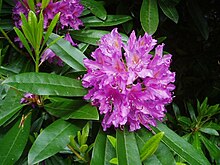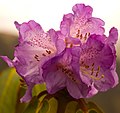Rhododendron
| Rhododendron | |
|---|---|

| |
| Rhododendron ponticum | |
| Scientific classification | |
| Kingdom: | |
| (unranked): | |
| (unranked): | |
| (unranked): | |
| Order: | |
| Family: | |
| Genus: | Rhododendron |
| Subgenera | |
Source: RBG, Edinburgh | |
Rhododendron (from the Greek: rhodos, "rose", and dendron, "tree") is a genus of flowering plants in the family Ericaceae. It is a large genus with over 1000 species and most have showy flower displays. It includes the plants known to gardeners as azaleas. It is the national flower of Nepal.
The Rhododendron is a genus characterized by shrubs and small to (rarely) large trees, the smallest species growing to 10-100 cm tall, and the largest, R. giganteum, reported to over 30 m tall.[1] The leaves are spirally arranged; leaf size can range from 1-2 cm to over 50 cm, exceptionally 100 cm in R. sinogrande. They may be either evergreen or deciduous. In some species the underside of the leaves is covered with scales (lepidote) or hairs (indumentum). Some of the best known species are noted for their many clusters of large flowers. There are alpine species with small flowers and small leaves, and tropical species such as section Vireya that often grow as epiphytes.
Distribution
Rhododendron is a very widely distributed genus, occurring throughout most of the Northern Hemisphere except for dry areas, and extending into the Southern Hemisphere in southeastern Asia and northern Australasia. The highest species diversity is found in the Himalayan mountains from Uttarakhand, Nepal and Sikkim to Yunnan and Sichuan, with other significant areas of diversity in the mountains of Indo-China, Korea, Japan and Taiwan. In addition, there are a significant number of tropical rhododendron species from southeast Asia to northern Australia, with 55 known species in Borneo and 164 in New Guinea.[2] Relatively fewer species occur in North America and Europe. Very few rhododendrons have been reported from South America (Bolivia and Ecuador) and Africa (Algeria) [3].
Classification

The species are organized by subgenus, section, subsection and series. These are currently divided into four large and four small subgenera:
- Subgenus Rhododendron L.: small leaf or lepidotes (with scales on the underside of their leaves); several hundred species, type: Rhododendron ferrugineum.
- The tropical rhododendrons (sect. Vireya, about 300 species) are usually included as a section in this subgenus, but sometimes split off as a ninth subgenus.
- Subgenus Hymenanthes (Blume) K.Koch: large leaf or elepidotes (without scales on the underside of their leaves); about 140 species, type: Rhododendron degronianum.
- Subgenus Pentanthera G.Don: deciduous azaleas; about 25 species, type Rhododendron luteum.
- Subgenus Tsutsusi: evergreen azaleas, about 110 species; type Rhododendron indicum.
- Subgenus Azaleastrum Planch.: five species; type Rhododendron ovatum.
- Subgenus Candidastrum (Sleumer) Philipson & Philipson: one species; Rhododendron albiflorum.
- Subgenus Mumeazalea: one species, Rhododendron semibarbatum.
- Subgenus Therorhodion: one species, Rhododendron camtschaticum.
Recent genetic investigations have caused an ongoing realignment of species and groups within the genus, and also have caused the old genus Ledum to be reclassified within subgenus Rhododendron. Further realignment within the subgenera is currently proposed [4][5], including the merging of subgenus Hymenanthes into subgenus Pentanthera.
Rhododendrons are extensively hybridized in cultivation, and natural hybrids often occur in areas where species ranges overlap. There are over 28,000 cultivars of Rhododendron in the International Rhododendron Registry held by the Royal Horticultural Society. Most have been bred for their flowers, but a few are of garden interest because of ornamental leaves and some for ornamental bark or stems.
Some species (e.g. Rhododendron ponticum in Ireland and the United Kingdom) are invasive as introduced plants, spreading in woodland areas replacing the natural understory. R. ponticum is difficult to eradicate, as its roots can make new shoots.

- Sample species
- Rhododendron atlanticum
- Rhododendron canadense
- Rhododendron catawbiense
- Rhododendron chapmanii
- Rhododendron ferrugineum
- Rhododendron groenlandicum
- Rhododendron hirsutum
- Rhododendron lochiae
- Rhododendron luteum
- Rhododendron macrophyllum
- Rhododendron maximum
- Rhododendron moulmainense
- Rhododendron occidentale
- Rhododendron ponticum
- Rhododendron schlippenbachii
- Rhododendron spinuliferum
- Rhododendron tomentosum
- Rhododendron nilagircum
A sample hybrid:
Toxicology
Some species are poisonous to grazing animals. These Rhododendrons have a toxin called grayanotoxin in their pollen and nectar. People have been known to become ill from eating honey made by bees feeding on rhododendron and azalea flowers. Xenophon described the odd behavior of Greek soldiers after having consumed honey in a village surrounded by rhododendrons. Later, it was recognized that honey resulting from these plants have a slightly hallucinogenic and laxative effect.[citation needed] The suspect rhododendrons are Rhododendron ponticum and Rhododendron luteum (formerly Azalea pontica), both found in northern Asia Minor. Eleven similar cases have been documented in Istanbul, Turkey during the 1980s.[6] Rhododendron is extremely toxic to horses, with some animals dying within a few hours of ingesting the plant, although most horses tend to avoid it if they have access to good forage.
Use in landscaping
Both species and hybrid rhododendrons (including azaleas) are used extensively as ornamental plants in landscaping in many parts of the world, and many species and cultivars are grown commercially for the nursery trade. Rhododendrons are often valued in landscaping for their structure, size, flowers, and the fact that many of them are evergreen.[7] Azaleas are frequently used around foundations and occasionally as hedges, and many larger-leafed rhododendrons lend themselves well to more informal plantings and woodland gardens, or as specimen plants. In some areas, larger rhododendrons can be pruned to encourage more tree-like form, with some species such as R. arboreum and R. falconeri eventually growing to 10-15 m or more tall.[7]
Commercial growing
Rhododendrons are grown commercially in many areas for sale, and are occasionally collected in the wild, a practice now rare in most areas. Larger commercial growers often ship long distances; in the United States most of them are located on the west coast (Oregon, Washington and California). Large-scale commercial growing often selects for different characteristics than hobbyist growers might, such as resistance to root rot when over-watered, ability to be forced into budding early, ease of rooting or other propagation, and saleability.[8]
Planting and care
Like other ericaceous plants, most rhododendrons prefer acid soils with a pH of roughly 4.5-5.5; some tropical Vireyas and a few other rhododendron species grow as epiphytes and require a planting mix similar to orchids. Rhododendrons have fibrous roots and prefer well-drained soils high in organic material. In areas with poorly-drained or alkaline soils, rhododendrons are often grown in raised beds using mediums such as composted pine bark.[9] Mulching and careful watering are important, especially before the plant is established.
Insects and diseases
There are a number of insects that either target rhododendrons or will opportunistically attack them. Rhododendron borers and various weevils are major pests of rhododendrons, and many caterpillars will attack rhododendrons. Major diseases include Phytophthora root rot, stem and twig fungal dieback; Ohio State University Extension provides information on maintaining health of rhododendronsRhododendrons can easily be suffocated by other plants.
Rhododendron species are used as food plants by the larvae of some members of the Order Lepidoptera (butterflies and moths) (See List of Lepidoptera that feed on rhododendrons).
Medicinal potential
It has been reported that the plant is of anti-inflammatory and hepatoprotective functions against related diseases, which is probably due to its anti-oxidant efficacy sourced from flavonoids, saponins and phenolic compounds,[10][11][12] Xiong et al. have found that the root of the plant is able to regulate kidney function by reducing the activity of NF-κB.[13]
Symbolism
Rhododendron ponticum is the state flower of Indian-administered Kashmir (Indian Controlled) and Pakistan Controlled Kashmir. Rhododendron arboreum (Lali Gurans) is the national flower of Nepal. Rhododendron niveum is the state tree of Sikkim in India. Rhododendron is also the state tree of the state of Uttarakhand, India. Rhododendron catawbiense, the predominant Rhododendron in the Appalachian Mountains, is the state flower of West Virginia, and is in the Flag of West Virginia. Rhododendron macrophyllum, the predominant rhododendron on the Pacific Coast and in the Cascade Mountains is the state flower of Washington.
Gallery
-
Rhododendron decorum subsp. diaprepes
-
Wild Rhododendrons in Kashmir by Edward Molyneux; painted before 1908
-
Flowering Rhododendrons in Whitwick Leicestershire
-
Rhododendron luteum
-
Rhododendrons in Sōrakuen garden, Kobe
Footnotes
- ^ Tree rhododendrons
- ^ Argent, G. Rhododendrons of subgenus Vireya. 2006. Royal Horticultural Society. ISBN 1-902896-61-0
- ^ Global Biodiversity Information Facility. http://data.gbif.org
- ^ Goetsch, L. A., Eckert, A. J. & Hall, B. D. (2005). The molecular systematics of Rhododendron (Ericaceae): A Phylogeny based upon RPB2 gene sequences. Sys. Bot. 30(3): 616-626.
- ^ Summary of Goetsch-Eckert-Hall results
- ^ Nurhayat Sütlüpmar, Afife Mat and Yurdagül Satganoglu Poisoning by toxic honey in Turkey. Archives of Toxicology. Volume 67, Number 2, pages 148-150, February, 1993
- ^ a b Huxley, A., ed. (1992). New RHS Dictionary of Gardening. Macmillan
- ^ Peter A. Cox (1993). The Cultivation of Rhododendrons. B. T. Batsford, London ISBN 0-7134-5630-2 (pp80-1)
- ^ Soil information for planting rhododendrons
- ^ Erdemoglu, Nurgun; et al. (2008). "Bioassay-guided isolation of anti-inflammatory and antinociceptive principles from a folk remedy, Rhododendron ponticum L. leaves". Journal of Ethnopharmacology. 119 (1, 2). Academic journal: 172–178. doi:10.1016/j.jep.2008.06.021.
{{cite journal}}:|access-date=requires|url=(help); Check date values in:|accessdate=(help); Cite has empty unknown parameter:|coauthors=(help); Explicit use of et al. in:|first=(help); Unknown parameter|accessyear=ignored (|access-date=suggested) (help) - ^ Prakash, T.; et al. (2008). "Hepatoprotective activity of leaves of Rhododendron arboreum in CCl4 induced hepatotoxicity in rats". Journal of Medicinal Plants Research. 2 (11). Academic journal: 315–320. Retrieved 9 May.
{{cite journal}}: Check date values in:|accessdate=(help); Cite has empty unknown parameter:|coauthors=(help); Explicit use of et al. in:|first=(help); Unknown parameter|accessyear=ignored (|access-date=suggested) (help) - ^ Agarwal, S.S. (1988). "Anti-inflammatory activity of flowers of Rhododendron arboreum (SMITH) in rat's hind paw oedema induced by various phlogistic agents". Indian Journal of Pharmacology. 20 (2): 86–89. Retrieved 9 May.
{{cite journal}}: Check date values in:|accessdate=(help); Unknown parameter|accessyear=ignored (|access-date=suggested) (help); Unknown parameter|coauthors=ignored (|author=suggested) (help) - ^ Xiong, Jing; et al. (2009). "The effect of root of rhododendron on the activation of NF-κ B in a chronic glomerulonephritis rat model". Retrieved 9 May.
{{cite web}}: Check date values in:|accessdate=(help); Cite has empty unknown parameter:|coauthors=(help); Explicit use of et al. in:|first=(help); Unknown parameter|accessyear=ignored (|access-date=suggested) (help)
References
- Cox, P. A. & Kenneth, N. E. The Encyclopedia of Rhododendron Species. 1997. Glendoick Publishing. ISBN 0-9530533-0-X.
- Davidian, H. H. The Rhododendron Species. In four volumes from 1982-1995. Timber Press. ISBN 0-917304-71-3, ISBN 0-88192-109-2, ISBN 0-88192-168-8, ISBN 0-88192-311-7.
See also
- List of plants poisonous to equines
- Chinese herbology 50 fundamental herbs
External links
- Rhododendrons from Turkey, Anatolia
- Flora of China: Rhododendron
- Description of damage caused by Rhododendrons in the UK
- Information on rhododendrons at the Ericaceae web pages of Dr. Kron at Wake Forest University.
- Information on Vireyas
- Information on Rhododendrons by Marc Colombel, founder of the Société Bretonne du Rhododendron.
- Extensive information on rhododendron species: the history of their discovery, botanical details, toxicity, classification, cultural conditions, care for common problems, and suggestions for companion plants by Steve Henning.
- History of Rhododendrons
- Historical Survey of Rhododendron Collecting - With Emphasis on its Close Associations with Horticulture








